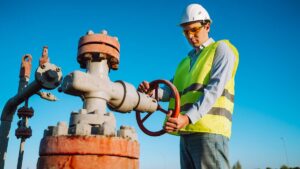Perth Basin gas success continues to draw exploration

More drilling will be carried out in the Perth Basin. Pic: via Getty Images
Successful exploration draws increased activity and with a string of successful gas wells, that is certainly true for the Perth Basin in Western Australia.
Mineral Resources (ASX:MIN) and Norwest Energy (ASX:NWE) have successfully suspended their Lockyer Deep-1 gas discovery well for future production testing and have released the Ensign 970 rig.
In September, the JV confirmed that the well had intersected 20.2m of net gas pay in the primary target Kingia Sandstone.
Notably, this section has average porosity of 16% and permeability of 500 milidarcies, which are promising signs that gas will flow easily.
Little wonder then that Norwest managing director Iain Smith is keen to start testing the well.
“Lockyer Deep-1 has confirmed a very significant conventional gas resource and we are delighted to have reached this key milestone in operations,” he noted.
“We now look forward to production testing of what we believe is a high deliverability Kingia reservoir, with the test program to be conducted by early Q1 CY2022.
“Our joint venture operator is pushing forward with plans to acquire 2D and 3D seismic surveys across permits EP368 and EP426, commencing Q1 CY2022, the results of which will serve to optimise the forward appraisal and exploration drilling program.”
Adding further value, operator Mineral Resources will take at least some of the gas production for its own use to replace diesel fuel that powers its and other Western Australian mining operations.
More Perth Basin drilling
There’s more drilling occurring at the Perth Basin with the Ensign 970 rig mobilising to drill the Walyering-5 well in EP447 for Strike Energy (ASX:STX) and Talon Energy (ASX:TPD).
This well is designed to test the updip potential of the Walyering wet-gas discovery, which flowed up to 13.5 million standard cubic feet of gas per day from multiple zones during testing.
Walyering-5 will be drilled to a total depth of 3,138m and targets up to 38.7 billion cubic feet of gas and 0.98 million barrels of condensate.
The high levels of condensate will improve the economics of the field while the high-quality of the gas, which has less than 1% carbon dioxide, means that little processing is required which in turn lowers the cost of production.
Related Topics

UNLOCK INSIGHTS
Discover the untold stories of emerging ASX stocks.
Daily news and expert analysis, it's free to subscribe.
By proceeding, you confirm you understand that we handle personal information in accordance with our Privacy Policy.








